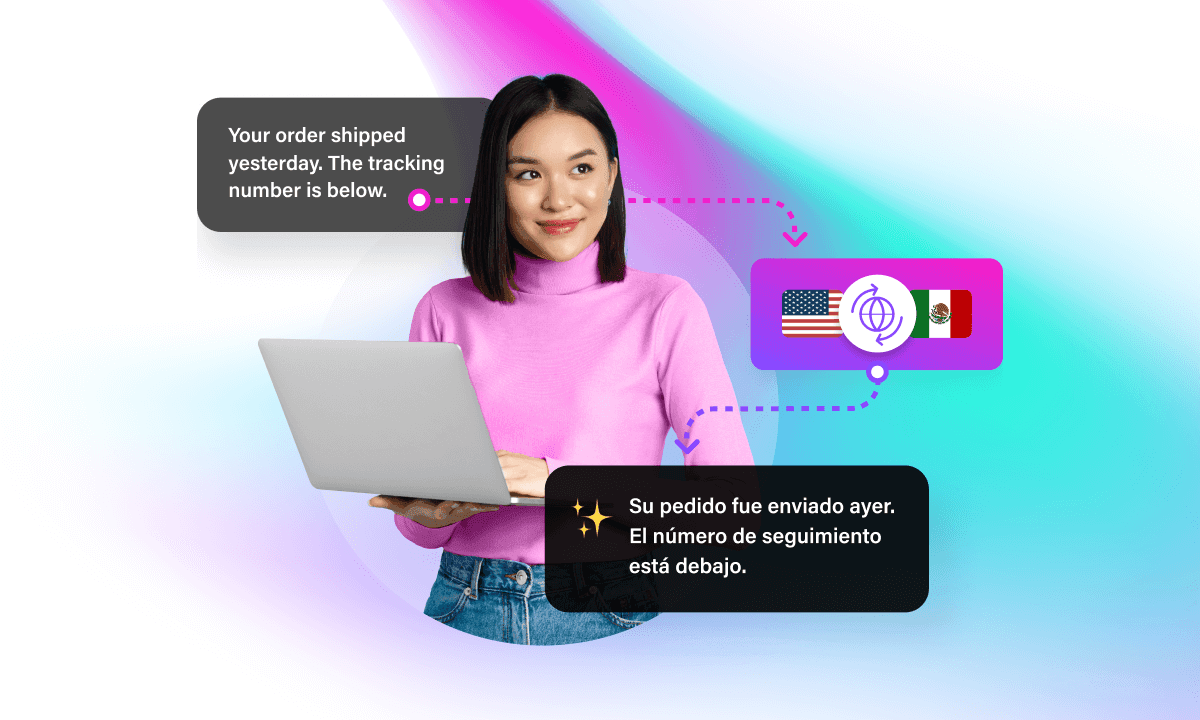Könnte der mehrsprachige Kundensupport für Ihr Unternehmen einen Unterschied machen?
Wenn die Antwort ein klares Ja ist…
Lesen Sie weiter, um mehr über einige mehrsprachige Support-Optionen zu erfahren.
Es gibt eine ganze Reihe von Ansätzen
Es ist wichtig, dass Sie die richtige Lösung für Ihr Unternehmen wählen. Es geht nicht nur darum, eine mehrsprachige Wissensdatenbank zu haben. Es gibt noch viel mehr zu bedenken, wenn es darum geht, Kundensupport in einer Vielzahl von Sprachen anzubieten.
Die richtigen mehrsprachigen Kundenservice-Tools können dazu beitragen, Ihren Umsatz zu steigern und die Loyalität und Bindung Ihrer Kunden zu stärken.
Wenn Sie denken, dass die Antwort nein lautet…
Denken Sie noch einmal nach. In diesem Artikel erfahren Sie, warum.
In diesem Artikel
- Was ist mehrsprachiger Kundensupport und warum sollte man ihn nutzen?
- Die verschiedenen Möglichkeiten, mehrsprachigen Support anzubieten
- Schlussfolgerung
Was ist mehrsprachiger Kundensupport und warum sollte man ihn nutzen?
Die offensichtliche Antwort ist, dass es darum geht, Kunden in ihrer primären oder bevorzugten Sprache zu unterstützen. Lassen Sie uns also nach dem Warum fragen.
1. Früher, vor dem Internet, war das nicht so wichtig
Für die meisten Unternehmen waren die Märkte kleiner, und es bestand einfach keine Notwendigkeit, mehrsprachigen Support anzubieten.
2. Früher hatten Unternehmen Kundenbetreuer im Ausland
Damals setzten Unternehmen, die ihre Produkte im Ausland verkauften, ausnahmslos ‚Mittelsmänner‘ oder Agenten ein, um ihre grenzüberschreitenden Transaktionen abzuwickeln und mit englischen Nicht-Muttersprachlern zu kommunizieren.
3. Um Ihren Vertrieb und Support zu optimieren, müssen Sie heute in der Lage sein, in anderen Sprachen zu kommunizieren
Und das nicht nur, um Menschen aus Übersee zu beherbergen. Heutzutage sind die meisten Länder mehr als je zuvor multirassisch, multikulturell und kosmopolitisch. Die Welt ist in der Tat kleiner geworden als früher, und das Internet hat die Welt in Ihre Hand gebracht, so dass die Kundenbetreuung zentralisiert werden kann!

4. Es zeigt den Besuchern Ihres Geschäfts einen gewissen Respekt
Wenn Sie einen mehrsprachigen Kundendienst anbieten, der in der Lage ist, mit einem Besucher in dessen Muttersprache zu sprechen, geben Sie ihm sofort das Gefühl, respektiert und erwünscht zu sein.
5. Sie geben Ihren Kunden ein gutes Gefühl für Sie, Ihr Unternehmen und sich selbst
Wenn Sie Menschen auf ihrer Customer Journey in ihrer Muttersprache helfen, können Sie die Zufriedenheit und das Engagement Ihrer Kunden steigern.
6. Kunden fühlen sich willkommen
Indem Sie mit Ihren Kunden in deren Muttersprache sprechen, stellen Sie auch eine kulturelle Verbindung her, durch die sich Ihre Kunden willkommen und bei Ihrer Marke „zu Hause“ fühlen können.
7. Kunden kommen wieder und wollen mehr
Kundensupport kann die Loyalität fördern, die Kundenbindung stärken, neue Verkäufe anregen und Wiederholungskäufe fördern.
8. Sie werden von Bewertungen und Empfehlungen profitieren
Ein Kundensupport, der mit internationalen Kunden auf internationalen Märkten zurechtkommt, indem er mit den Menschen in ihrer Muttersprache kommuniziert, wird potenzielle Kunden ermutigen, Ihnen helfen, bestehende Kunden zu halten und mit der Zeit mehr Kunden durch positives Feedback in Bewertungen und Empfehlungen zu gewinnen. Erfahren Sie mehr über Bewertungen und Weiterempfehlungen.

Wenn Sie ein eCommerce-Geschäft haben, wissen Sie bereits , wie wichtig ein gutes Kundenerlebnis ist.
9. Gute Kundenbetreuung erleichtert die Kommunikation mit dem Kunden
Wenn Sie mit einem Kunden in seiner eigenen Sprache kommunizieren können, werden Sie ihm ein besseres Kundenerlebnis bieten. So einfach ist das.
Und jetzt genießen Sie diese Tatsache:
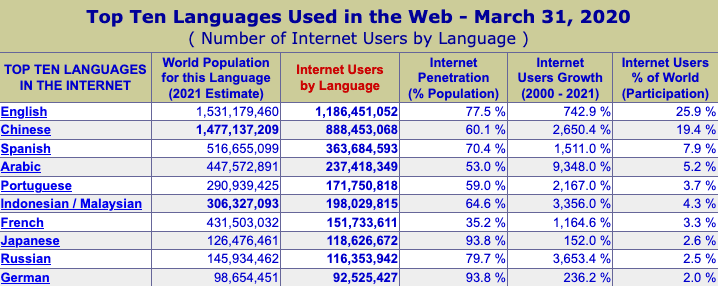
Nur ein Viertel der Internetnutzer auf der ganzen Welt verwenden Englisch als ihre primäre Internetsprache. Werfen wir einen Blick auf einige weitere beeindruckende Zahlen:
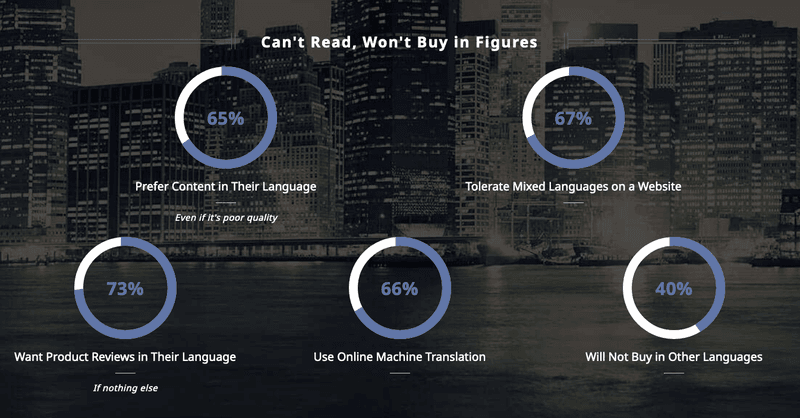
CSA Research beauftragte Kantar mit der Befragung von Tausenden von Verbrauchern in 29 Ländern, es war also keine kleine Umfrage. Hier sind einige der Ergebnisse.
- 65% bevorzugen Inhalte in ihrer eigenen Sprache.
- 67% tolerieren gemischte Sprachen auf einer Website.
- 73% wünschen sich Produktbewertungen in ihrer Sprache.
- 66% verwenden maschinelle Online-Übersetzung.
- 40% werden nicht in anderen Sprachen kaufen.
Das sind in der Tat beeindruckende Zahlen. Ein wichtiger Aspekt, den wir berücksichtigen müssen, ist, dass wir, wenn wir über mehr Sprachen, übersetzte Artikel und maschinelle Übersetzung sprechen, um den Umsatz zu steigern, nicht nur über das globale Publikum auf der ganzen Welt sprechen, sondern oft auch über die Notwendigkeit, verschiedene Sprachen auch für lokale Märkte einzusetzen.
Die Länder sind heutzutage multikulturell. Denken Sie also daran, dass selbst wenn Ihre Zielgruppe in Ihrem Land ansässig ist, nicht alle Ihre lokalen Kunden Englisch sprechen werden.
Lassen Sie uns einen Blick auf das mehrsprachige Amerika werfen
Nehmen Sie Kalifornien als Beispiel. Laut World Facts sprechen etwas mehr als 20 Millionen Menschen in Kalifornien Englisch als Hauptsprache, während über 10 Millionen Spanisch sprechen.
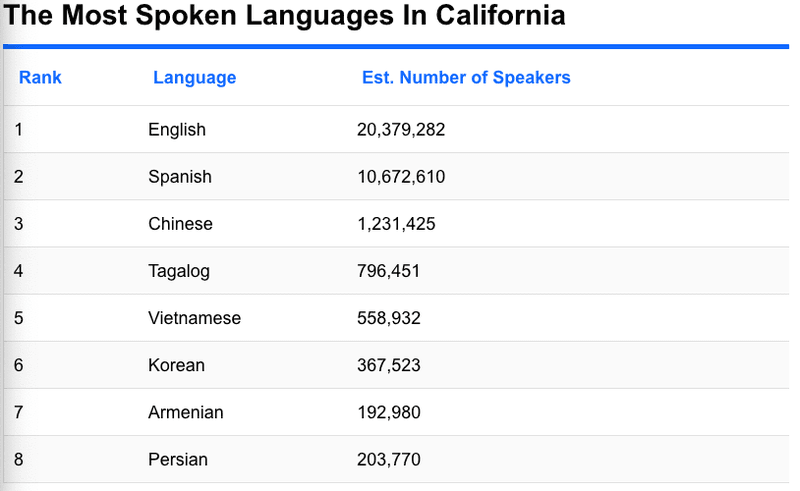
Dies unterstreicht die Tatsache, dass Sie selbst dann, wenn Sie in Ihrem angeblich englischsprachigen Land auf den lokalen Markt abzielen, zumindest die wichtigsten in dem Land gesprochenen Sprachen in Ihrer Wissensbasis abdecken sollten, um Ihre Kunden bedienen zu können.
Dies ist in den USA nahezu unverzichtbar, wenn Sie Ihren Kundensupport optimieren und gleichzeitig den Umsatz, die Kundenbindung und die Markentreue fördern möchten.
Denken Sie nicht nur an die Verbraucher. Die Verbraucher sind nicht der einzige Teil der Bevölkerung, der mehr als nur Google Translate sucht, wenn es um den Kundensupport geht.
Geschäftskunden, insbesondere SaaS-Kunden, würden es begrüßen, wenn sie Hilfe und Support in ihrer Sprache erhalten würden.
Und auch auf die Gefahr hin, das Offensichtliche zu sagen: Denken Sie daran, dass Geschäftskunden auch Verbraucher sind und umgekehrt.
Aber ein mehrsprachiger Kundensupport muss so teuer sein?
Nun, das muss nicht sein, denn es gibt eine Reihe kostengünstiger Möglichkeiten, die Sprachbarriere zu überwinden.
Doch bevor wir uns einige der wichtigsten Möglichkeiten ansehen, wie Sie effizient und kostengünstig einen mehrsprachigen Kundensupport anbieten können, sollten Sie einige Vorbereitungen und Nachforschungen in und um Ihr Unternehmen anstellen.
Reden Sie mit Ihren verschiedenen Abteilungen und Teams
Das ist wichtig, denn die ersten Annahmen können falsch sein.

Konzentrieren Sie sich nicht nur auf die Mitarbeiter Ihres Kundensupports. Reden Sie mit Ihren Kundenbetreuern, Produktmanagern, Kommunikations- und Fulfillment-Teams und, wenn Sie können, mit Ihren Kunden.
Sie werden erstaunt sein, wie viele Informationen sie Ihnen darüber geben können, wie Ihr Unternehmen ein besseres Kundenerlebnis bieten könnte und sollte, indem Sie mit Menschen aus anderen Ländern in deren Muttersprache sprechen.
Die verschiedenen Möglichkeiten, mehrsprachigen Support anzubieten
Die Entscheidung, welche Art von mehrsprachigem Support für Ihr Unternehmen am besten geeignet ist, hängt davon ab, was Sie tun und an wen Sie verkaufen.
Es hängt auch davon ab, wie Ihr Kundensupport aufgebaut ist und ob Sie über Kundenbetreuer verfügen.
Vielleicht haben Sie bereits Kundenbetreuer, die Übersetzungstools verwenden, aber vielleicht wäre es besser, wenn Sie Ihrem Support-Team eine alternative Möglichkeit bieten würden, Support in mehr als einer Sprache anzubieten?
1. Studieren Sie den Inhalt Ihres aktuellen Kundensupports
Wenn Sie auf Ihrer Website oder in Ihrem Chat-System Vorlagen für Hilfe, Support und häufig gestellte Fragen (FAQ) haben, warum lassen Sie diese nicht einfach übersetzen?
Eine übersetzte FAQ-Seite ist wartungsarm und muss nur gelegentlich überprüft werden, um sicherzustellen, dass sie auf dem neuesten Stand bleibt.
Ein zusätzlicher Bonus dieses Ansatzes ist, dass Ihre Kundensupport-Teams nicht so viele Support-Anfragen direkt bearbeiten müssen und dass Sie Support-Tickets verwenden können, wenn Sie im Chat sind, um auf Anfragen hinzuweisen, die einen menschlichen Eingriff erfordern.
Wenn Sie sich dafür entscheiden, Ihre Hilfe- und Support-Inhalte in die Sprachen Ihrer Kundschaft übersetzen zu lassen, warum lassen Sie nicht gleichzeitig auch Ihre Website übersetzen?
Und was ist mit all den anderen Sicherheiten, die Sie für Ihre Kunden bereithalten?
Ziehen Sie in Erwägung, Ihre genauen Anweisungen, Schnellstartanleitungen, Benutzerhandbücher, YouTube-Anleitungsvideos und CRM-Kommunikation ebenfalls übersetzen zu lassen.
Hier gibt es Skaleneffekte, und Sie verbessern Ihre Suchmaschinenoptimierung sowie Ihre Präsenz auf ausländischen Märkten, was sich spürbar auf Ihren Umsatz auswirken kann.
Die Kommunikation mit Ihrem Kundenstamm in mehreren Sprachen verschafft Ihrem Unternehmen außerdem einen Wettbewerbsvorteil gegenüber anderen Unternehmen, die ähnliche Produkte oder Dienstleistungen anbieten.
2. Erwägen Sie eine Ausweitung der Selbstbedienungsunterstützung
Wenn Sie einen Kunden dazu bringen, sich selbst zu bedienen, sollte sich das nicht negativ auf das Kundenerlebnis auswirken, vorausgesetzt, die Einrichtung der Selbstbedienung in mehreren Sprachen ist gut gemacht und für den Kunden einfach zu bedienen.
Viele effiziente Unternehmen verfügen über eine mehrsprachige Wissensbasis, um Sprachbarrieren zu überwinden und einen globalen Markt zu bedienen.
Self-Service kann viele Formen annehmen. Es kann sich um automatisierte mehrsprachige Support-Nachrichten im Live-Chat handeln, um den Einsatz von Chatbots oder um mehrsprachige, leicht zu durchsuchende FAQs.
Chatbots können die Browsersprache eines Kunden erkennen und automatisch zu dieser Muttersprache wechseln, wenn dieser einen Chat beginnt und Kundenunterstützung anbietet.
3. Statten Sie Ihre Contact Center-Teams aus
Auch wenn der menschliche Kontakt zweifellos am besten ist, kann der Einsatz von Tools zur automatischen Übersetzung eingehender Anfragen für Kontaktzentren, die mit globalen Verbrauchern zu tun haben, sehr hilfreich sein.
Sie können sogar einen Lokalisierungsworkflow einrichten, der bei Bedarf bestimmte Anfragen an muttersprachliche Mitarbeiter Ihres Supportteams weiterleitet.
Es gibt einige nützliche Übersetzungs-Apps, die Ihrem Support-Team beim Umgang mit internationalen Kunden helfen können.
Hier sind einige Beispiele.
LangOps von Unbabel verwendet eine „KI-gestützte, von Menschen verfeinerte maschinelle Übersetzungstechnologie“, um die Sprachstrategie eines Unternehmens in den Bereichen Vertrieb, Produkt, Marketing und Kundendienst zu zentralisieren.

Mit Lokalise können Sie jede Art von digitalem Asset wie eine Web-App oder eine mobile App übersetzen. Dies kann eine große Hilfe für Ihre Design-, Produkt- und Kundendienstteams sein.
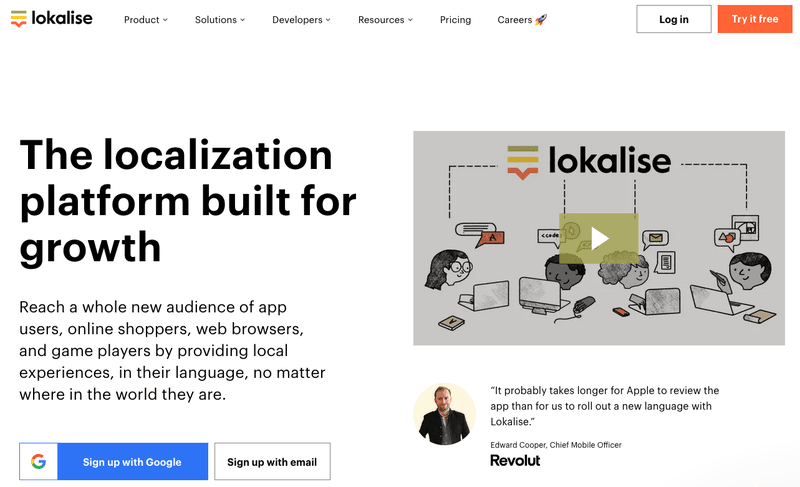
4. Outsourcing an ein hervorragendes mehrsprachiges Supportteam
Es gibt einige sehr gute Agenturen, die einen mehrsprachigen Kundenservice anbieten.
Ein zusätzlicher Vorteil des Outsourcings Ihres Bedarfs an mehreren Sprachen ist, dass Sie Ihr Team für Kundenanfragen nicht damit überlasten, maschinelle Übersetzungstools im Haus zu betreiben.
Eine maschinelle Übersetzung ist zwar praktisch, aber nicht so gut wie eine echte Übersetzung. Muttersprachler verleihen Ihren Texten eine menschliche, kulturelle Note, die Ihre Kunden besser anspricht.
Außerdem müssen Sie keine neuen Mitarbeiter einstellen, die verschiedene Sprachen sprechen, um mehrsprachigen Kundensupport zu leisten.
Schlussfolgerung
Unabhängig davon, in welcher Branche Sie tätig sind, welches Produkt oder welche Dienstleistung Sie verkaufen und welchen Zielmarkt Sie ansprechen, sollten Sie ernsthaft in Erwägung ziehen, Ihrer Zielgruppe einen mehrsprachigen Kundendienst anzubieten.
So viel hängt vom Kundenerlebnis ab
Ganz gleich, ob Sie Ihr Kundenerlebnis durch maschinelle Übersetzung, Dolmetschen am Telefon oder sogar durch verstärkten Self-Service-Support optimieren, das Angebot verschiedener Sprachen kann sich positiv auf Ihren Gewinn auswirken.
Die Chancen stehen gut, dass das ideale Szenario für Sie und Ihr Unternehmen eine Mischung aus all den verschiedenen Möglichkeiten ist, die wir in diesem Artikel betrachtet haben.
Nehmen Sie die Ersteinrichtung vor und sprechen Sie mit Ihren Teams – und warum starten Sie nicht eine kostenlose Testversion unserer Kundensupport-Tools, die ein- und ausgehende Nachrichten automatisch in die Landessprache übersetzen?
Interessieren Sie sich für andere Möglichkeiten, Ihr Geschäft anzukurbeln? Hier finden Sie 20 Möglichkeiten, die Konversionsraten Ihres E-Commerce zu steigern.
